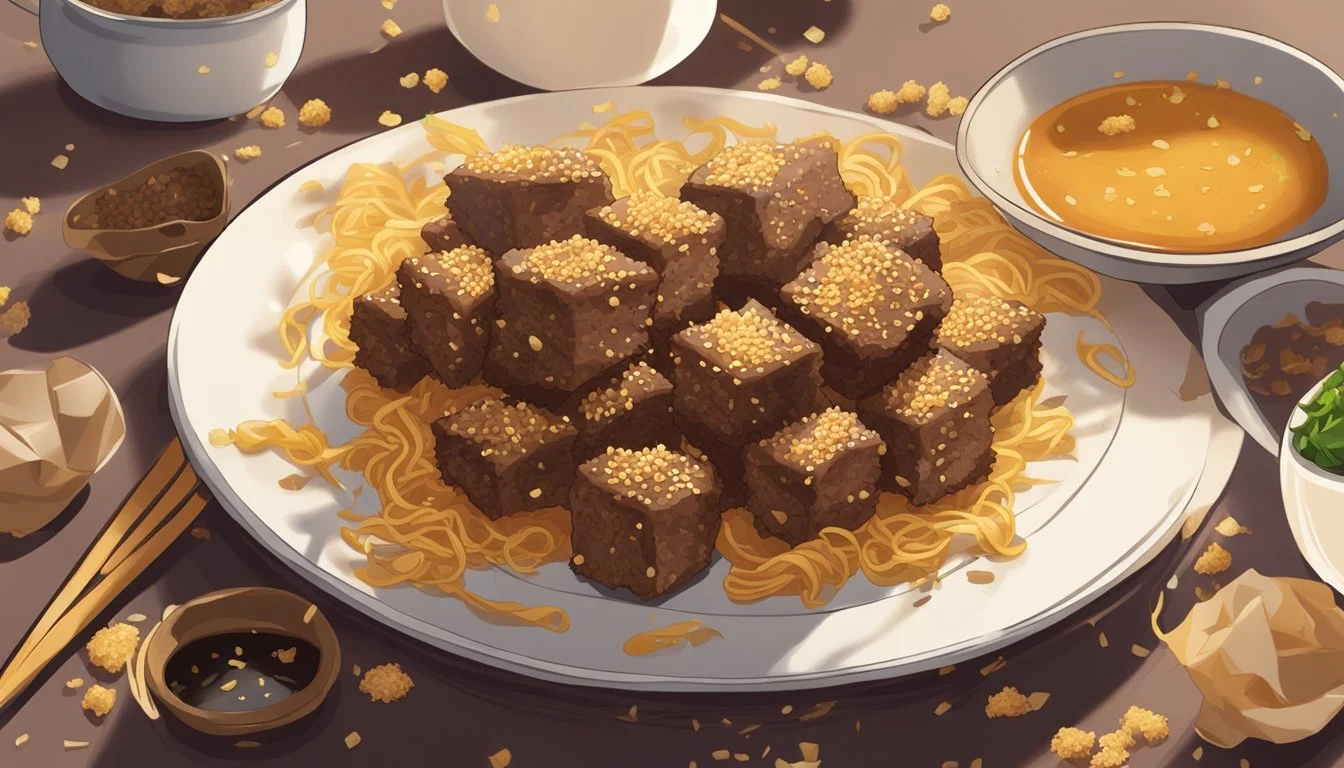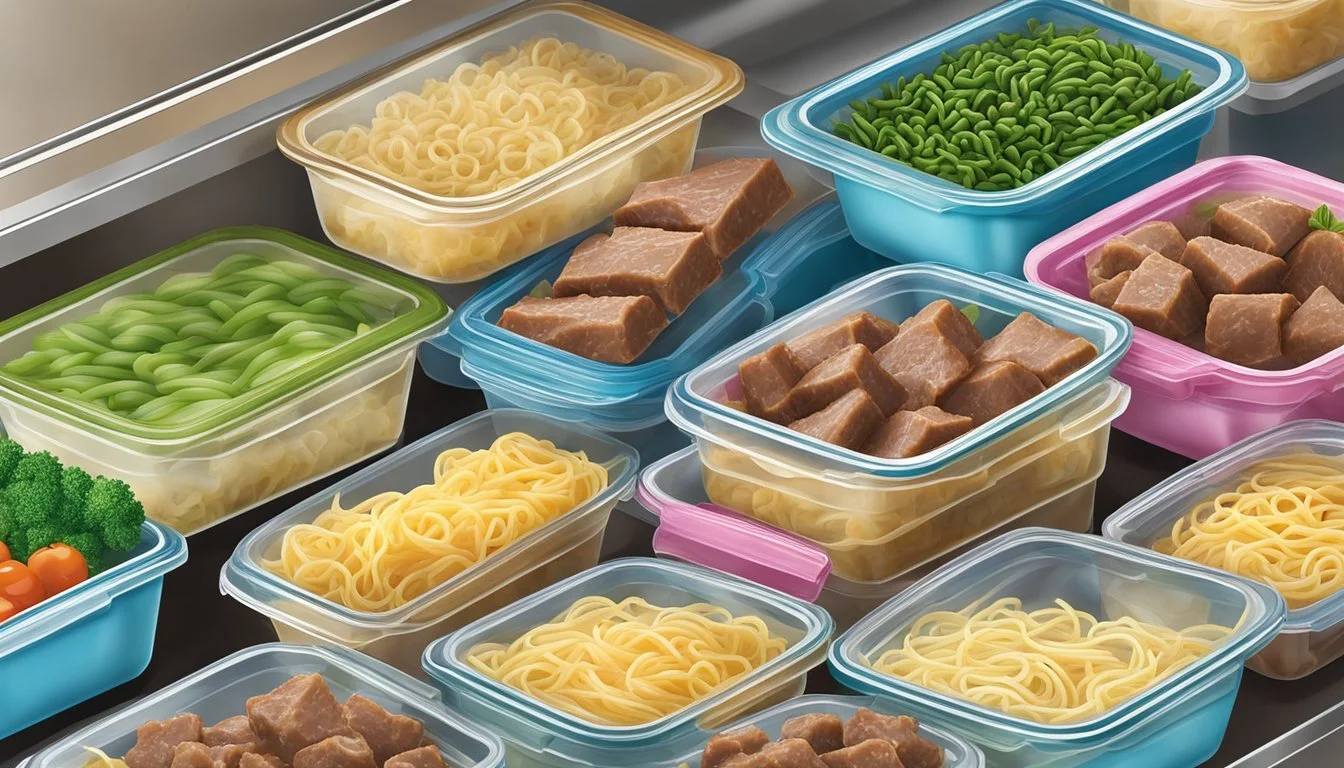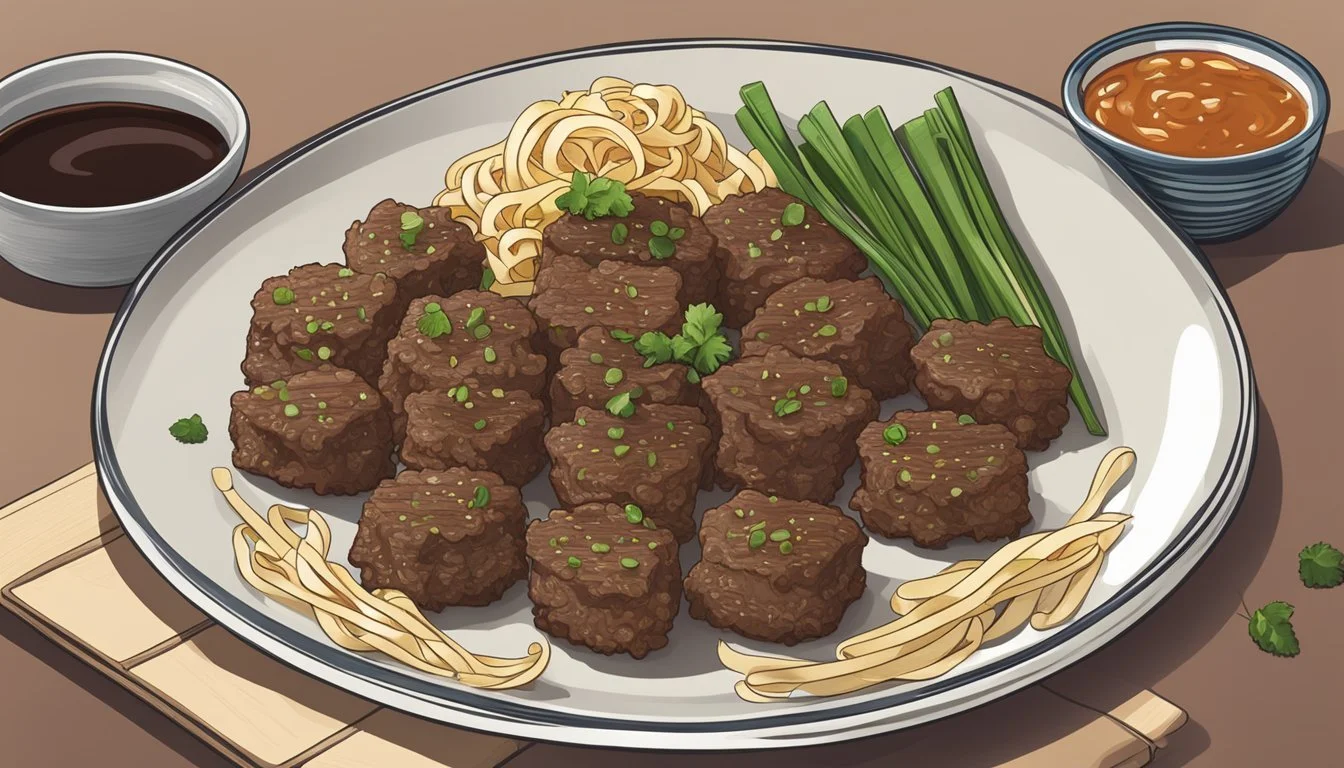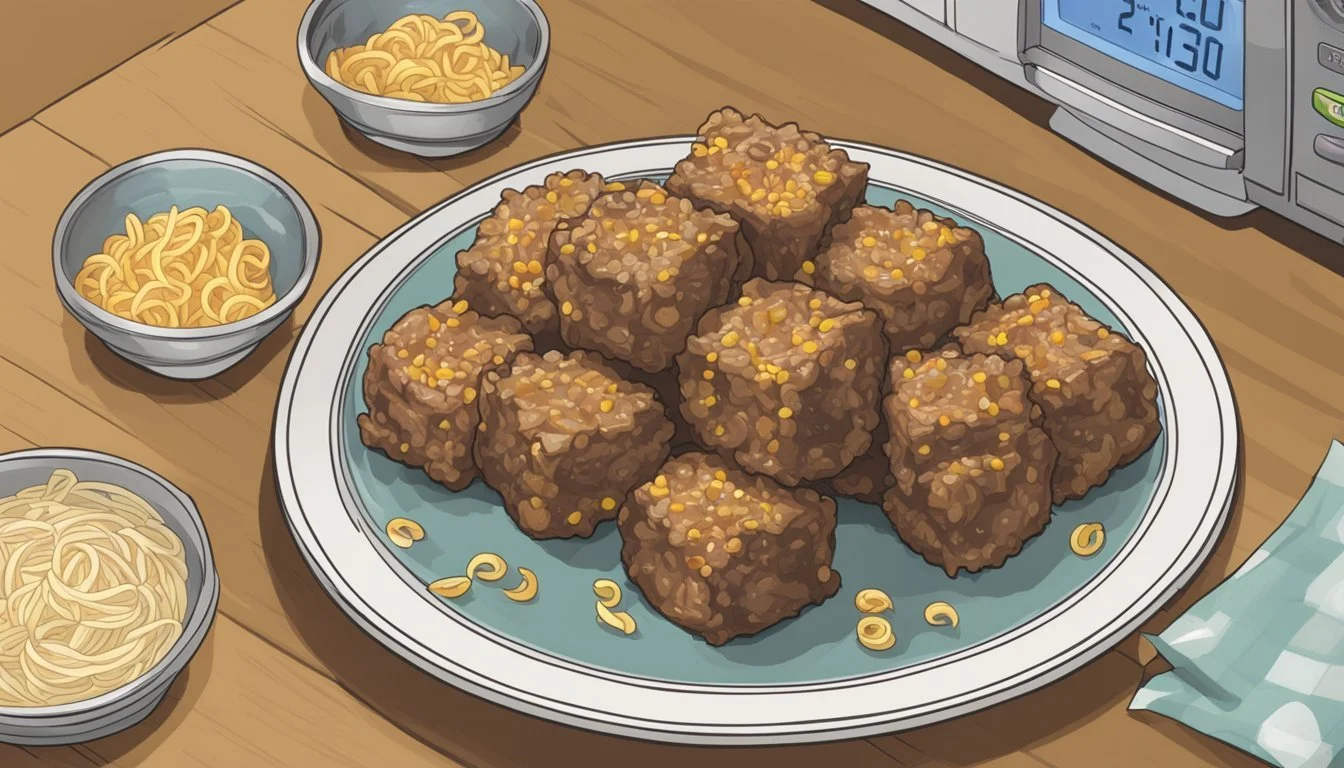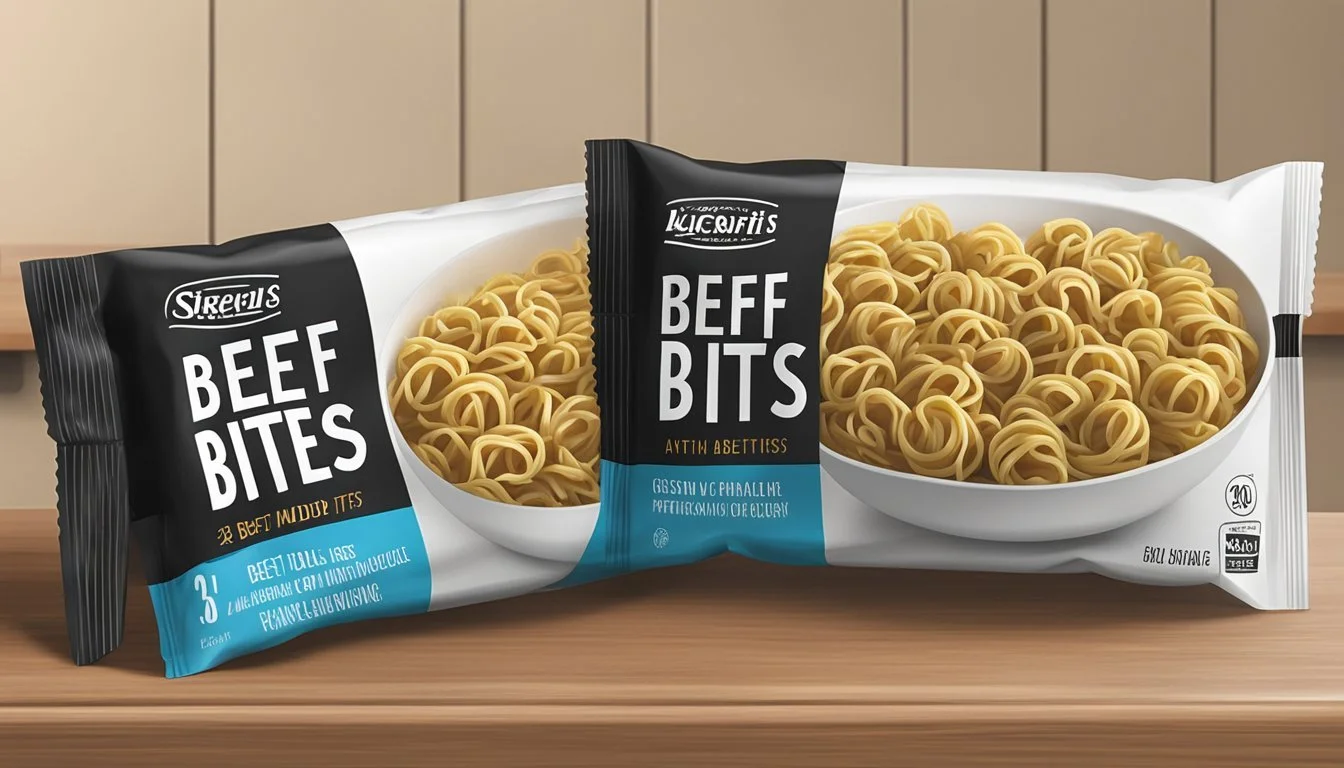How Long Do Beef and Noodle Bites Last?
Storage Tips and Shelf Life
Beef and noodles, a classic comfort food, can be a hearty and delightful meal for many. Homemade beef and noodle bites can last for 3 to 4 days in the refrigerator when properly stored. This provides a convenient option for meal planning throughout the week. For longer storage, these bites can be frozen, maintaining their quality for up to 2-3 months.
Proper storage is key to ensuring the longevity and safety of your beef and noodle bites. After cooking, leftovers should be refrigerated within two hours to reduce the risk of bacterial growth. When reheating, ensure the beef and noodles are heated thoroughly to an internal temperature of at least 165°F to ensure safety.
Cooked pasta, including the noodles in beef and noodle bites, also follows similar storage guidelines. It keeps well in the fridge for approximately 3 to 5 days. If your dish begins to smell strange or looks off, it’s best to discard it to avoid any foodborne illnesses.
Understanding Beef and Noodle Bites
Beef and noodle bites are a popular dish made up of seasoned beef and pasta, with various recipes adding unique twists inspired by comfort foods like beef stroganoff or beef stew.
Composition
Beef and noodle bites typically consist of tender beef chunks and pasta. The beef is often seasoned with salt, pepper, and various other seasonings. Flour is sometimes used to coat the beef, providing a thicker texture when cooked.
The pasta component can range from egg noodles to other varieties. Water or beef broth is essential for cooking the pasta and to prevent it from drying out. In many recipes, ingredients like cream are added towards the end to enhance the flavor and richness of the dish.
Popular Variations
There are several popular variations of beef and noodle bites, each bringing its own unique taste. A beef stroganoff twist incorporates sour cream and mushrooms along with the beef and noodles. Another popular variant resembles a beef stew, which includes additional vegetables like carrots and potatoes.
Salisbury steak variations might add a more savory quality by incorporating a specific beef patty mix and gravy. These slight changes can drastically alter the taste and texture of the beef and noodle bites, making each version distinct yet familiar in its comfort-food appeal.
Proper Storage Techniques
Proper storage of beef and noodle bites is essential to maintain their freshness and prevent food-borne illnesses like food poisoning. Here are best practices for refrigeration, freezing, and food safety.
Refrigeration
Beef and noodle bites should be stored in the refrigerator at a temperature of 40°F (4.4°C) or lower. Use airtight containers or vacuum-sealed bags to prevent air and moisture from spoiling the food.
Ideally, consume refrigerated beef and noodle bites within 3 to 4 days. Pay attention to any unusual smells, colors, or textures as these could be indicators of spoilage. The USDA recommends reheating leftovers to an internal temperature of 165°F (73.9°C) to kill any bacteria.
Freezing
For longer storage, freezing is an effective option. Place beef and noodle bites in freezer-safe containers or vacuum-sealed bags to maintain quality and prevent freezer burn. Label each package with the date to monitor storage duration.
Store the food at a consistent, safe temperature of 0°F (-17.8°C) or lower. Frozen beef and noodle bites can last up to 2-3 months without significant loss of quality, but always check for freezer burn before consumption.
Food Safety Considerations
Food safety should always be a priority when storing leftovers. Follow the “two-hour rule”: refrigerate or freeze beef and noodle bites within two hours of cooking to prevent bacterial growth. Never leave food out for extended periods, especially in warm environments.
Symptoms of food poisoning include nausea, vomiting, diarrhea, and fever. The USDA's FoodKeeper app offers additional guidance on storage times and conditions. Be vigilant about handwashing, using clean utensils, and maintaining proper hygiene practices to minimize foodborne illnesses.
Preparation and Cooking Tips
To create a dish that is both flavorful and tender, it's essential to prepare the beef and noodles correctly and choose an appropriate cooking method. Adding finishing touches will enhance the overall presentation and taste.
Preparing Beef and Noodles
When choosing beef, cuts like chuck roast or ground beef can be effective. For a richer flavor, beef broth or beef stock is recommended. Begin by cutting the beef into bite-sized pieces and season it generously with salt and pepper. This step ensures even seasoning throughout.
To cook the noodles, bring a pot of salted water to a boil and follow the package instructions. Egg noodles are a popular choice, but other varieties like fettuccine can also work well.
Pre-cook the beef by browning it in a skillet with olive oil. This adds depth to the flavor. Adding flour while browning can also help thicken the eventual gravy.
Cooking Methods
Choose your cooking method based on the desired texture and flavor profile. Three popular methods include slow cooker, Instant Pot, and stovetop.
Slow Cooker: Ideal for hands-off cooking. Combine browned beef, noodles, beef broth, and seasonings in the slow cooker and cook on low for 6-8 hours. This method results in very tender beef.
Instant Pot: Perfect for quicker meals. Sauté the beef first, then add the other ingredients. Cook on high pressure for 35-45 minutes. This retains moisture and deep flavors.
Stovetop: Offers the most control over the cooking process. Brown the beef in a dutch oven and then simmer with broth, Worcestershire sauce, and other seasonings for 1.5 to 2 hours. The noodles can be cooked separately and added at the end.
Finishing Touches
The final steps are crucial for enhancing the dish. To create a rich gravy, make a slurry using water and cornstarch and stir it into the cooking liquid until it thickens suitably. For a creamier texture, incorporate a dollop of sour cream in the last few minutes of cooking.
Fresh parsley can be sprinkled on top as a garnish for added flavor and color. Finally, adjust the seasoning with additional salt and pepper as needed before serving. These touches elevate the overall presentation and taste of the beef and noodles.
Optimal Serving Suggestions
Enhancing beef and noodle bites involves pairing them with well-chosen side dishes and optimizing seasoning. These elements work together to elevate the meal's flavor and visual appeal.
Complementary Side Dishes
Beef and noodle bites pair excellently with a variety of side dishes. For a comforting and hearty option, consider serving mashed potatoes. Their creamy texture balances the more robust flavors of the beef.
Rice is another great choice, easily absorbing the savory juices of the beef and adding a light, fluffy element to the plate.
Salads made with fresh greens and colorful veggies can add a refreshing contrast.
Roasted potatoes, crispy on the outside and fluffy inside, offer a different texture and richness.
Seasoning Adjustments
To elevate the flavor of beef and noodle bites, be precise with your seasonings. Common ingredients include black pepper, garlic powder, and onion powder. These staples bring out the beef's natural savoriness.
Fresh or dried herbs like thyme and parsley can add a distinct, aromatic depth.
Adjust the garlic and onion powder levels depending on your taste preference and the dish's flavor profile.
For those who enjoy a slightly bolder taste, adding a hint of crushed red pepper flakes can create a mild heat.
Reheating and Leftover Ideas
Reheating beef and noodle bites properly ensures they remain delicious and safe to eat. Transforming leftovers into new dishes can add variety to your meals.
Reheating for Best Quality
To reheat beef and noodle bites, use an oven to maintain texture. Preheat the oven to 275 degrees Fahrenheit. Place bites on a baking sheet, cover with aluminum foil, and bake for about 25 minutes.
A microwave is convenient but can make noodles mushy. To retain some texture, wrap the bites in waxed or parchment paper and heat for 45 to 60 seconds. Stir halfway through to ensure even reheating.
For a stovetop method, use a non-stick pan on medium heat. Add a few drops of water or broth to prevent sticking. Heat for about 5 minutes, stirring occasionally.
Avoid using a microwave for dishes with crunchy elements like bacon, as it can make them soggy. Reheat those in a toaster oven instead for better results.
Transforming Leftovers
Turn beef and noodle bites into a new dish. Incorporate them into a chicken noodle soup recipe for added protein. Cut the bites into smaller pieces and mix with chicken broth, mushrooms, and egg noodles.
Create a beef stroganoff by combining them with a cornstarch slurry. Mix leftover bites with sour cream, mushrooms, and the slurry for a creamy sauce over freshly cooked noodles.
Try a stir-fry by tossing the leftovers with vegetables like bell peppers and broccoli. Add soy sauce and a touch of sesame oil for an easy meal.
Experiment with a new recipe by mixing the bites into an omelet or frittata. Combine with mozzarella cheese, and bake for a satisfying breakfast or brunch.
These ideas ensure that leftovers never feel repetitive and always taste fresh.
Deciphering Shelf Life
Understanding the shelf life of beef and noodle bites involves recognizing expiration dates and identifying spoilage indicators. Shelf life can vary depending on storage conditions and preparation methods.
Expiration Dating
Expiration dates provide a guideline for the best quality of beef and noodle bites. Typically, unopened fresh beef and noodles can last in the refrigerator for up to 1-2 days, while unopened dried noodle bites can remain shelf-stable for up to a year. Once opened, fresh beef should be consumed within 1-2 days, and dried noodles within a few months.
Storage conditions are crucial. Keeping products in a cool, dry place or a refrigerator can significantly extend their usability. For freezing, beef and noodle bites can last for several months, often up to 6 months. Always refer to the manufacturer’s manual and label for precise information.
Spoilage Indicators
Recognizing spoilage indicators is essential for food safety. For beef, look for changes in color—a brownish or grayish hue often signals spoilage. An off or sour smell is another clear indicator. When it comes to texture, beef that feels sticky or slimy should be discarded.
Noodle bites, especially fresh ones, may change in texture if spoiled, becoming either too soft or overly hard. They might also emit an unusual odor. Always perform a quick smell and touch test before consuming.
Storing these items properly can help maintain freshness and reduce waste. Adhering to these practices ensures that you enjoy your beef and noodle bites safely.
Techniques for Extending Longevity
Proper storage and cooking techniques can significantly increase the shelf life of beef and noodle bites, ensuring they remain fresh and safe to eat for a longer period.
Advanced Storage Solutions
Vacuum sealing is a key method to extend the lifespan of beef and noodle bites. Removing air from packaging reduces exposure to bacteria and slows down spoilage. Use a vacuum sealer to package portions individually.
Airtight containers also play a crucial role in preservation. When storing leftovers, place beef and noodle bites in airtight containers to prevent exposure to moisture and contaminants. Label containers with dates to keep track of storage time.
Refrigeration at 36 to 38 degrees Fahrenheit is optimal for extending freshness. Beef should be consumed within 3-5 days when refrigerated, while ground beef should be consumed within 1-2 days. For freezing, store beef in freezer-safe bags and use within 6-12 months for best quality.
Creative Cooking Methods
Incorporating manual cooking techniques like brining is another effective method. Mix water, curing salt, and brown sugar, then soak beef for several weeks. This traditional method helps to preserve and enhance flavor.
Using appliances like the instant pot or slow cooker can prolong the edibility of meals by repurposing leftovers. For instance, leftover beef can be easily shredded and cooked with garlic and onion in an instant pot to create new dishes, increasing their lifespan.
Including garlic and onion in recipes not only boosts flavor but also utilizes antiseptic properties that can contribute to preservation. Both ingredients can extend the perceived freshness of prepared meals like beef and noodle bites.


